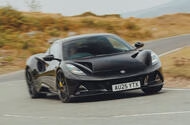What’s Changing for the Lotus Emira in 2027?
If you’ve been following Lotus, you know the Emira has been a bit of a lifeline for the brand—a classic sports car in a world that’s rapidly going electric. But big changes are on the horizon. Lotus has officially confirmed that the Emira will get a plug-in hybrid version in 2027, right alongside a facelift for the V6 model. This isn’t just a minor update; it’s a strategic move to keep the Emira compliant with the tough new Euro 7 emissions regulations.
Why is this such a big deal? Well, for starters, it means Lotus isn’t abandoning its sports car roots, even as the automotive world pivots toward electrification. Instead, they’re doubling down—blending their traditional performance DNA with cutting-edge hybrid tech. The outcome? Game-changing, if they get it right.
What’s Behind the Shift to Plug-In Hybrid Power?
Let’s be honest: the writing’s been on the wall for pure combustion engines in Europe for a while now. The Euro 7 standards are pushing automakers to rethink everything, and Lotus is no exception. The current four-cylinder Emira, powered by a Mercedes-AMG engine, looks set to bow out. The V6, which uses a Toyota-sourced engine, can’t be upgraded to meet the new rules either.
So, what’s Lotus doing? They’re rolling out their new Hyper Hybrid technology—first seen in their Eletre SUV—into the Emira. This isn’t just a bolt-on electric motor. It’s a ground-up rethink, designed to deliver both performance and efficiency. The tech is being developed through a close partnership between Lotus Tech in China and Lotus Cars in the UK, blending global resources with that famous British sports car know-how.
How Will the New Emira Plug-In Hybrid Perform?
Lotus hasn’t spilled all the details yet, but there are some clues. A few years back, they tested a plug-in hybrid Evora prototype with a 1.2-liter three-cylinder engine, an electric motor, and a 17kWh battery. That setup promised around 35 miles of electric-only range. While that particular car never made it to production, it shows Lotus has been thinking about hybrids for a while.
With the Emira, expect a more advanced system—likely with more power, better range, and a seamless blend of electric and petrol performance. The goal is clear: keep the Emira’s sharp handling and driver engagement, but add the flexibility and efficiency modern buyers (and regulators) demand.
What Does This Mean for Lotus Workers and the UK Plant?
It’s been a turbulent time for Lotus employees, especially at the Hethel plant in Norfolk. Recent news of job cuts—about 40% of the UK workforce—sparked real anxiety about the future. But Lotus CEO Feng Qingfeng has reaffirmed the company’s commitment to its UK operations, emphasizing that the new hybrid Emira is part of a broader strategy to keep Lotus Cars at the forefront of high-performance engineering.
The decision to combine Lotus Tech with Lotus Cars is meant to drive efficiency and foster innovation. In theory, this should help Lotus weather the industry’s rapid changes while keeping its British heart beating strong.
How Are Lotus Sales and Finances Holding Up?
It hasn’t all been smooth sailing. In the first half of 2025, Lotus deliveries dropped nearly 50% to just 2,813 cars. Emira deliveries took a particularly hard hit, falling 64% to 891 units. The main culprit? A sudden hike in US tariffs, which forced Lotus to halt Emira exports to its biggest market. Thankfully, after negotiations, those tariffs were cut from 27.5% to 15%, and exports resumed in July.
Financially, Lotus posted a net loss of $313 million in the first half of 2025. That sounds rough, but it’s actually an improvement over the previous half-year, when losses hit $424 million. So, while the numbers aren’t pretty, there’s at least some momentum in the right direction.
Why Is Lotus Betting on Hybrids Instead of Going Fully Electric?
This is where things get interesting. Lotus made a big push into electric vehicles with the Eletre SUV and Emeya saloon, but sales haven’t met expectations. The luxury market, it turns out, isn’t quite ready to go all-in on EVs—at least not at the pace some predicted. That’s why Lotus is pivoting to plug-in hybrids, which offer a bridge between the old and the new.
By introducing the Hyper Hybrid system in the Emira, Lotus is hedging its bets. They’re giving customers the performance and driving experience they crave, with the added benefit of electric-only driving for short trips. It’s a pragmatic move, and one that could help Lotus stay relevant as the industry evolves.
What’s Next for Lotus and the Emira?
There’s a lot riding on the success of the hybrid Emira. For Lotus, it’s more than just a new model—it’s a statement of intent. They’re not giving up on sports cars, and they’re not afraid to innovate. If the Hyper Hybrid tech delivers on its promise, the Emira could set a new benchmark for what a modern sports car can be.
And for fans? It means the Lotus driving experience isn’t going anywhere. It’s just getting a little greener—and maybe even a bit more exciting.
The Takeaway for Enthusiasts and Buyers
If you love the idea of a sports car that blends tradition with tomorrow’s tech, keep an eye on the Emira. Lotus is betting big on hybrids, and the next few years will show whether that gamble pays off. For now, it’s clear they’re not content to fade quietly into the background. They’re pushing forward, adapting, and—just maybe—about to surprise us all.

